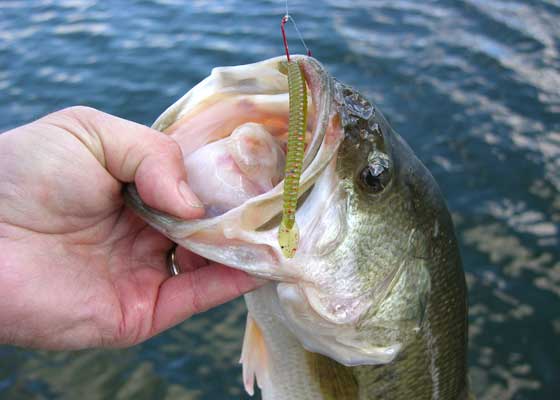Plastic Worms

Plastic worms have caught more bass than any other type of lure and an essential lure in any experienced and amateur tackle box.
Tips for fishing with plastic worms
- The best way to use the worm is to inch it along the bottom, crawling it through the weeds and climbing it over timber.
- When fishing for Largemouth and Suwannee bass, cast your line just past a lily pad and reel it in slowly.
Pros and cons
There’s a downside to using worms. They are a catch-all and almost always guarantee a mixed bag of fish in areas that contain a variety of fish. We suggest when using plastic worms to catch Largemouth bass, focus on areas where these bass dominate.
They have the advantage of being a very simple and easy lure to use. To help reduce the risk of catching sunfish, perch and other unwanted fish, avoid using small plastic worms.
- Largemouth Bass lures: Use a 6 or 7 inch worm and 6 inch lizards work best for most bass fishing conditions.
- Smallmouth Bass: the best lures are the 4 inch or the more typical 6 to 7 inch dark pumpkin colored worms and lizards.
With over 5 million types to choose from, plastic worms are one of the most popular baits in the world.
Here’s 3 recommendations with rigging advice.
1. Texas Rigged Worms
Texas-rigged worms use the hook point embedded in the worm so that they’re relatively weedless while the Carolina rigged worm is fished weightless and off the bottom on a long snell.
- Texas-rigged worms are cast at specific locations and structures, then fished slowly. Carolina rigs take the open water approach of trolling the presentations. It may be suspended off the bottom or hunkered down in the weeds.
Bass are not the only fish that enjoy a worm or two. Pike and walleye are eager to knock down a good worm. Walleye prefer the 4 inch finesse worms while pike can’t be caught without a decent leader because of their teeth.
2. Carolina Rigged Worms
When fishing in deeper water or windy conditions, the Texas rig looses it’s ability to provide vibrations as it touches underwater structures or takes a nibble. It’s in these conditions that the Carolina rig works best.
- The original Carolina rig used a bullet or egg weight.
- This goes on the line first followed by a glass bead.
- The bead makes noise when the weight hits it and also protects the knot on the swivel.
- Tie a swivel on a short leader and then tie the swivel with the leader to the main line.
- Next tie on your hook of choice to the end of the leader.
To find out more about leaders, click here.
3. Dropshot Rigged Worms
Dropshotting requires a light line usually up with 4 to 10lb fluorocarbon line. Dropshotting is used to fish shallow water to deep structure.
- To set up, use a Palomar knot and tie a small dropshot hook on to the line leaving about an 18 inches tag.
- To ensure that the hook stands out perpendicular from the line, run the tag end through the eye on the face side of the hook and pop the knot through.
Plastic worms are considered the best lure to catch Largemouth Bass in many circles and the results often back this up.
- Straight tail worms work well in all applications including drop shotting, shakey head, Texas rig and Carolina rig.
Click here to buy plastic worms at best prices on Amazon
Most anglers start out as children curious about what lies below the water and an interest in catching the fish soon follows. And like most young anglers, worms are the easiest live bait at hand and with a little bit of work, they don’t cost any money.
As we grow older, we continue to use worms but tend to prefer the plastic kinds. They work just as well and you don’t have to worry about keeping them alive.



